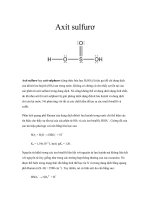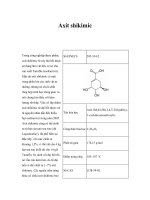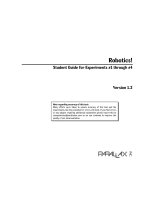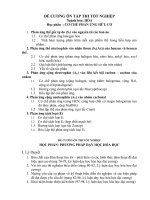Tài liệu Lightning rod doc
Bạn đang xem bản rút gọn của tài liệu. Xem và tải ngay bản đầy đủ của tài liệu tại đây (886.84 KB, 10 trang )
Lightning rod
A lightning rod (AUS) or lightning conductor (UK) is a metal rod or conductor mounted on top of a
building and electrically connected to the ground through a wire, to protect the building in the event of
lightning. If lightning strikes the building it will preferentially strike the rod, and be conducted harmlessly to
ground through the wire, instead of passing through the building, where it could start a fire or cause
electrocution. A lightning rod is a single component in a lightning protection system. In addition to rods
placed at regular intervals on the highest portions of a structure, a lightning protection system typically
includes a rooftop network of conductors, multiple conductive paths from the roof to the ground, bonding
connections to metallic objects within the structure and a grounding network. The rooftop lightning rod is a
metal strip or rod, usually of copper or aluminum. Lightning protection systems are installed on structures,
trees, monuments, bridges or water vessels to protect from lightning damage. Individual lightning rods are
sometimes called finials, air terminals or strike termination devices. The United States Patent Office labels
"Lightning protectors" in Class 174 (Electricity: conductors and insulators), Subclass 2 (Lightning protectors)
and Subclass 3 (Rods). The lightning rod was invented by Benjamin Franklin in the Americas in 1749 and,
perhaps independently, by Prokop Diviš in Europe in 1754
History
As buildings became taller, lightning becomes more of a threat. Lightning can damage structures made of
most materials (masonry, wood, concrete and steel) as the huge currents involved can heat materials, causing
a potential for fire, and also water to high temperatures.
Some of the most ancient lightning conductors can be found in Sri Lanka in places like the Kingdom of
Anuradhapura that dates back to thousands of years. The Sinhalese kings who mastered construction of stupas
and advanced building structures, installed a metal tip made of copper on the highest point of every building
to conduct any lightning charge. In many parts of the world ancient Buddhist monuments have been destroyed
by lightning strikes but not in Sri Lanka.
Russia
A lightning conductor may have been intentionally used in Nevyansk tower, where the roof of the tower is
crowned with a metallic rod in the shape of a gilded sphere with spikes. The Nevyansk Tower was built
between 1725 and 1732, so the Russians created a lightning rod some 25 years before Benjamin Franklin.
Generated by Foxit PDF Creator © Foxit Software
For evaluation only.
However, the true purpose and intent behind the metal rooftop remains
unknown
Wooden church with lightning rods and grounding cables
Generated by Foxit PDF Creator © Foxit Software
For evaluation only.
"Machina meteorologica" invented by Václav Prokop Diviš worked like a lightning rod.
The church tower of many European cities, usually the highest structure, was the building often hit by
lightning. Early on, Christian churches tried to prevent the occurrence of the damaging effects of lightning by
prayers. Priests prayed,
"temper the destruction of hail and cyclones and the force of tempests and lightning; check hostile
thunders and great winds; and cast down the spirits of storms and the powers of the air."
Peter Ahlwardts ("Reasonable and Theological Considerations about Thunder and Lightning", 1745) advised
individuals seeking cover from lightning to go anywhere except in or around a church.
[3]
In Europe, the
lightning rod was independently invented by Václav Prokop Diviš between 1750 to 1754.
United States
In the United States, the pointed lightning rod conductor, also called a "lightning attractor" or "Franklin
rod," was invented by Benjamin Franklin in 1749 as part of his groundbreaking explorations of electricity.
Franklin speculated that, with an iron rod sharpened to a point at the end,
"The electrical fire would, I think, be drawn out of a cloud silently, before it could come near enough
to strike...."
Franklin speculated about lightning rods for several years before his reported kite experiment. This
experiment, in fact, took place because he was tired of waiting for Christ Church in Philadelphia to be
completed so he could place a lightning rod on top of it.
In the 19th century, the lightning rod became a decorative motif. Lightning rods were embellished with
ornamental glass balls
[4]
(now prized by collectors). The ornamental appeal of these glass balls has been used
in weather vanes. The main purpose of these balls, however, is to provide evidence of a lightning strike by
shattering or falling off. If after a storm a ball is discovered missing or broken, the property owner should then
check the building, rod, and grounding wire for damage.
Balls of solid glass occasionally were used in a method purported to prevent lightning strikes to ships and
other objects. Although this failed to work, it is worth noting. The basic principle was that glass objects, being
non-conductors, are seldom struck by lightning. Therefore, goes the theory, there must be something about
glass that repels lightning. Hence the best method for preventing a lightning strike to a wooden ship was to
bury a small solid glass ball in the tip of the highest mast. The random behavior of lightning combined with
observers' confirmation bias ensured that the method gained a good bit of credence even after the
development of the marine lightning rod soon after Franklin's initial work.
The first lightning conductors on ships were supposed to be hoisted when lightning was anticipated, and had a
low success rate. In 1820 William Snow Harris invented a successful system for fitting lightning protection to
the wooden sailing ships of the day, but despite successful trials which began in 1830, the British Royal Navy
did not adopt the system until 1842, by which time the Imperial Russian Navy had already adopted the
system.
Generated by Foxit PDF Creator © Foxit Software
For evaluation only.
Nikola Tesla's U.S. Patent 1,266,175 was an improvement in lightning protectors. The patent was granted due
to a fault in Franklin's original theory of operation; the pointed lightning rod actually ionizes the air around
itself, rendering the air conductive, which in turn raises the probability of a strike. Many years after receiving
his patent, in 1919 Dr. Tesla wrote an article for The Electrical Experimenter entitled "Famous Scientific
Illusions", in which he explains the logic of Franklin's pointed lightning rod and discloses his improved
method and apparatus.
DuPont Explosives manufacturing sites were surrounded by pine trees. The needles on many pine trees can
act as tens of thousands of points for higher voltages to flow current into the air and lower the different
between the cloud to ground, and reduce the number of strikes per square mile of area. During the 1950s,
DuPont made nitroglycerin in some buildings and moved it in "Angel Buggies" to the packing building.
Employees at those sites were very sensitive to potential lightning strikes.
[5]
In the 1990s, the 'lightning points' were replaced as originally constructed when the statue of Freedom atop
the United States Capitol building in Washington, D.C. was restored.
[6]
The statue was designed with multiple
devices that are tipped with platinum. The Washington Monument also was equipped with multiple lightning
points,
[7]
and the Statue of Liberty in New York Harbor gets hit with lightning which is grounded out.
Structure protectors
Landscape suited for purpose of explanation: (1) Represents Lord Kelvin's "reduced" area of the region;
[8]
(2) Surface concentric with the Earth such that the quantities stored over it and under it are equal; (3) Building
on a site of excessive electrostatic charge density; (4) Building on a site of low electrostatic charge density.
(Image via U.S. Patent 1,266,175.)
[edit] Lightning diversion
Lightning rods convey the current from a strike to the ground or water via a low-resistance conductor. A
lightning strike is thus said to be diverted from the protected structure. However, diversion is a misnomer.
Rather, the lightning rod widely used attracts and intercepts a strike that terminates near a protected
structure.
[9]
There is some uncertainty as to why a lightning strike is attracted to a lightning rod or similar
protector, the leading assumption being that the air near the rod becomes ionized during an electrical storm,
and thus highly conductive relative to the surrounding air.
[9]
Main article: Lightning arrester
Generated by Foxit PDF Creator © Foxit Software
For evaluation only.
In telegraphy and telephony, a lightning arrester is placed where wires enter a structure, preventing damage to
electronic instruments within and ensuring the safety of individuals near them. Lightning arresters, also called
surge protectors, are devices that are connected between each electrical conductor in a power and
communications systems and the Earth. These provide a short circuit to the ground that is interrupted by a
non-conductor, over which lightning jumps. Its purpose is to limit the rise in voltage when a communications
or power line is struck by lightning.
The non-conducting material may consist of a semi-conducting material such as silicon carbide or zinc oxide,
or a spark gap. Primitive varieties of such spark gaps are simply open to the air, but more modern varieties are
filled with dry gas and have a small amount of radioactive material to encourage the gas to ionize when the
voltage across the gap reaches a specified level. Other designs of lightning arresters use a glow-discharge tube
(essentially like a neon glow lamp) connected between the protected conductor and ground, or myriad
voltage-activated solid-state switches called varistors or MOVs. Lightning arresters built for substation use
are impressive devices, consisting of a porcelain tube several feet long and several inches in diameter, filled
with disks of zinc oxide. A safety port on the side of the device vents the occasional internal explosion
without shattering the porcelain cylinder.'
[edit] Electric power system lightning protection
High-tension power lines carry a lighter conductor (sometimes called a 'pilot' or 'shield') wire over the main
power conductors. This conductor is grounded at various points along the link, or insulated from the tower
structures by small insulators that are easily jumped by lightning voltages. The latter allows the pilot wire to
be used for communications purposes, or to carry current for aircraft clearance lights. Electrical substations
may have a web of grounded wires covering the whole plant.
[edit] Lightning protection of mast radiators
Mast radiators are insulated from the ground by a gap at the base. When lightning hits the mast, it jumps this
gap. A small inductivity in the feed line between the mast and the tuning unit (usually one winding) limits the
voltage increase, protecting the transmitter from dangerously high voltages. The transmitter must be equipped
with a device to monitor the antenna's electrical properties. This is very important, as a charge could remain
after a lightning strike, damaging the gap or the insulators. The monitoring device switches off the transmitter
when the antenna shows incorrect behavior, e.g. as a result of undesired electrical charge. When the
transmitter is switched off, these charges dissipate. The monitoring device makes several attempts to switch
back on. If after several attempts the antenna continues to show improper behavior, possibly as result of
structural damage, the transmitter remains switched off.
Generated by Foxit PDF Creator © Foxit Software
For evaluation only.









